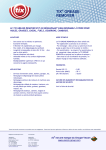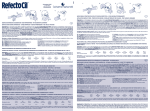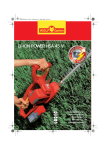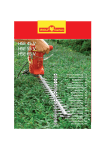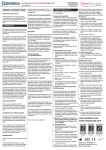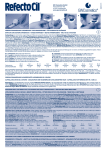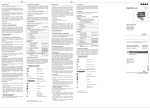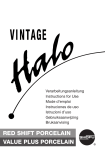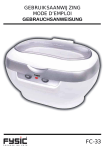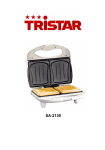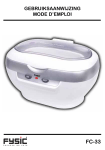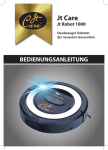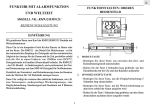Download Telecargar
Transcript
3C-BOND 3C-BOND: microfijne (0,01 tot 0,02 mm) bonding agent om porselein op constructies uit traditionele chroom-cobalt-legeringen te bakken Toepassingsgebied: kroon- en brugwerk en uitneembare Cr-Coconstructies 3C-BOND verhindert het ontstaan van een geelgroene verkleuring in de keramiekmassa, vooral in de dunne randgebieden bij Ni-Cr-legeringen. GEBRUIKSAANWIJZING Voorbereiding van de metaalconstructie Afstralen met Al2O3. Reinigen met een dampstraler of in een ultrasonisch bad, ofwel 10 minuten afkoken in gedistilleerd water. De metaalconstructie moet volledig droog zijn en mag enkel nog met een zuiver pincet vastgehouden worden. 3C-BOND met gedistilleerd water tot een crèmeachtige massa mengen en direct dekkend tot over de marginale randen aanbrengen. Reeds aangemengde 3C-BOND nooit hergebruiken. 3C-BOND zoals een opaker onder vacuüm opbakken. Voorverwarmtemperatuur: 650 °C (1200 °F) Temperatuurstijging: 55 °C (131 °F) per min. Eindtemperatuur: 980 °C (1800 °F) Na de brand de metaalconstructie onmiddellijk uit de oven verwijderen en ze aan de lucht laten afkoelen. 3C-BOND moet na deze behandeling een gele tot goudgele kleur vertonen. De opakerbrand volgens de instructies van de porseleinfabrikant uitvoeren. ALPHADENT NV Textielstraat 24 8790 Waregem, België T +32 56 629 100 F +32 56 629 101 E [email protected] PROBLEEMOPLOSSING Vóór gebruik Alvorens 3C-BOND op te bakken raden wij aan een proefbrand te doen op een Cr-Co-blokje of -gietkegel, om de reactie van 3C-BOND op de gebruikte Cr-Co-legering na te gaan. Er ontstaan groenzwarte vlekken. - Het 3C-BOND-mengsel was te dun. - De metaalconstructie was nog vettig of vochtig. - 3C-BOND werd meermaals aangemengd. In deze gevallen het werkstuk grondig reinigen en herbeginnen. 3C-BOND vertoont blazen. De metaalconstructie gedurende 10 minuten onder vacuüm ontgassen op 980 °C (1800 °F), alvorens opnieuw 3C-BOND aan te brengen. 3C-BOND vertoont barsten. Het 3C-BOND-mengsel was te dik. Opnieuw afstralen, grondig reinigen en weer 3C-BOND opbrengen en opbakken. Barsten in het porselein Indien na de 3C-BOND-brand geen gele doch een roestkleurige laag verschijnt, is de gebruikte Cr-Colegering niet geschikt of 3C-BOND werd opnieuw gebruikt. VEILIGHEIDSINSTRUCTIES Na contact met de huid Onmiddellijk afwassen met water en zeep. 3C-BOND irriteert de huid normalerwijs niet. Na contact met de ogen Reinig de ogen voorzichtig met zacht stromend water. Na inslikken Bij problemen een arts raadplegen. OPSLAG EN DUURZAAMHEID 3C-BOND in goed gesloten verpakking op een droge plaats bewaren. Het product is in ongeopende verpakking onbeperkt houdbaar. De verpakking mag met gewoon huisvuil weggegooid worden. Copyright© ALPHADENT NV 3/2012 Prospectus nr. 130.N/F/D/E/S/I-ed.C BTW BE 0414.789.321 RPR Kortrijk 3C-BOND bijsluiter 130.indd 1 3C-BOND 3C-BOND: bonding microfin (0,01 à 0,02 mm) pour la cuisson de céramique sur des constructions en alliage cobalt-chrome Champ d’application: couronnes, bridges et constructions amovibles en Co-Cr Le 3C-BOND empêche les changements de teinte vert jaune de la masse de céramique, surtout dans les zones marginales minces avec des alliages Ni-Cr. MODE D’EMPLOI Préparation de la construction métallique Décapez à l’Al2O3. Nettoyez à l’aide d’un jet de vapeur ou dans un bain à ultrasons, ou faites bouillir durant 10 minutes dans de l’eau distillée. La construction métallique doit être parfaitement sèche et ne peut alors être manipulée qu’avec des précelles propres. Mélangez le 3C-BOND à de l’eau distillée pour obtenir une consistance crémeuse et appliquez ce mélange en une seule couche couvrante jusqu’audessus des bords marginaux. Le 3C-BOND délayé ne peut jamais être réutilisé. Effectuez la cuisson du 3C-BOND sous vide comme un opaque. Température de préchauffe: 650 °C (1200 °F) Montée en température: 55 °C (131 °F) par min. Température finale: 980 °C (1800 °F) Après la cuisson, retirez immédiatement la construction métallique du four et laissez-la refroidir à l’air. Le 3C-BOND doit alors être de couleur jaune à jaune doré. Faites la cuisson d’opaque tel que conseillé par le fabricant de la céramique. ALPHADENT NV Textielstraat 24 8790 Waregem, Belgique T +32 56 629 100 F +32 56 629 101 E [email protected] RECTIFICATION D’ERREURS Avant l’emploi Avant de réaliser la cuisson du 3C-BOND sur la pièce de travail, il est conseillé de faire un essai sur un plot ou sur une masselotte en Co-Cr, afin de vérifier la réaction du 3C-BOND sur l’alliage Co-Cr utilisé. L’apparition de taches vertes noires - Dilution trop claire du 3C-BOND - La construction métallique était encore grasse ou humide. - Le 3C-BOND a été délayé plus d’une fois. Dans ces cas, il faut nettoyer soigneusement la pièce de travail et recommencer. Des bulles dans le 3C-BOND Dégazez la construction métallique durant 10 minutes sous vide à 980 °C (1800 °F), avant d’appliquer une nouvelle couche du 3C-BOND. Craquelage du 3C-BOND Le 3C-BOND n’a pas été suffisamment dilué. Décapez de nouveau, nettoyez soigneusement, appliquez une nouvelle couche du 3C-BOND et refaites la cuisson. Craquelage de la céramique Si après la cuisson du bonding la couche qui apparaît n’est pas de couleur jaune mais rouille, l’alliage Co-Cr utilisé est impropre ou le 3C-BOND a été réutilisé. CONSIGNES DE SÉCURITÉ Après contact avec la peau Laver immédiatement au savon et à l’eau. Le 3C-BOND normalement n’irrite pas la peau. Après contact avec les yeux Roncez les yeux soigneusement à l’eau courante. Après ingestion Consulter un médecin en cas de malaise. STOCKAGE ET DURABILITÉ Stockez le 3C-BOND dans l’emballage bien fermé dans un endroit sec. Dans son emballage d’origine fermé, sa durabilité est illimitée. L’emballage peut être déposé avec les ordures ménagères. Copyright© ALPHADENT NV 3/2012 Prospectus n° 130.N/F/D/E/S/I-ed.C TVA BE 0414.789.321 RPR Kortrijk 3C-BOND 3C-BOND: mikrofeines (0,01 bis 0,02 mm) Bonding-Material für die Aufbrenntechnik auf Konstruktionen aus traditionellen Chrom-Kobalt-Legierungen Indikationsbereich: Kronen- und Brückenarbeiten und herausnehmbare Cr-Co-Konstruktionen 3C-BOND verhindert das Entstehen einer gelbgrünen Verfärbung in der Keramikmasse, die besonders im dünnen Randgebiet bei Ni-CrLegierungen auftritt. VERARBEITUNGSANLEITUNG Vorbereitung des Metallgerüstes Abstrahlen mit Al2O3. Entweder reinigen mit einem Dampfstrahler oder in einem Ultraschallbad, oder 10 Minuten in destilliertem Wasser abkochen. Das Metallgerüst muss vollkommen trocken sein und darf nur noch mit einer sauberen Pinzette angefasst werden. 3C-BOND mit destilliertem Wasser zu einer cremenartigen Konsistenz mischen und sofort deckend bis über die Abschlussränder hinaus auftragen. Schon angemischtes 3C-BOND darf nie wieder gebraucht werden. ALPHADENT NV Textielstraat 24 8790 Waregem, Belgien T +32 56 629 100 F +32 56 629 101 E [email protected] FEHLERBESEITIGUNG Vor Gebrauch Vor der Verarbeitung von 3C-BOND empfehlen wir, auf einem Cr-CoWürfel oder -Gusskegel einen Probebrand zu machen, um die Reaktion von 3C-BOND auf Ihre übliche Cr-CoLegierung zu testen. Das Entstehen von grünschwarzen Flecken - Die 3C-BOND-Mischung war zu dünn. - Das Metallgerüst war noch feucht oder fettig. - 3C-BOND wurde mehrmals angemischt. In diesen Fällen das Werkstück gründlich reinigen und vornherein anfangen. 3C-BOND weist Blasen auf. Das Metallgerüst 10 Minuten unter Vakuum auf 980 °C (1800 °F) entgasen, bevor 3C-BOND erneut aufzutragen. 3C-BOND weist Sprünge auf. Die 3C-BOND-Mischung war zu dick. Erneut abstrahlen, gründlich reinigen und neues 3C-BOND auftragen und aufbrennen. Sprünge im Porzellan Wenn nach dem 3C-BOND-Brand keine gelbe, jedoch eine rostfarbene Schicht erscheint, ist die verwendete Cr-Co-Legierung nicht geeignet oder 3C-BOND wurde erneut gebraucht. 3C-BOND gleich wie Opaker unter Vakuum aufbrennen. SICHERHEITSHINWEISE Vorwärmtemperatur: 650 °C (1200 °F) Tenperaturanstieg: 55 °C (131 °F) pro Min. Endtemperatur: 980 °C (1800 °F) Hautkontakt Sofort mit Wasser und Seife waschen. Normalerweise reizt 3C-BOND die haut nicht. Nach dem Brand das Metallgerüst unmittelbar aus dem Ofen entfernen und an der Luft abkühlen lassen. 3C-BOND soll nach dieser Behandlung eine gelbe bis goldgelbe Farbe aufweisen. Den Opakerbrand nach den Anweisungen des Keramikmassenherstellers durchführen. Augenkontakt Augen vorsichtig mit fließendem Wasser spülen. Verschlucken Bei Unwohlsein Arzt hinzuziehen. LAGERUNG UND LEBENSDAUER 3C-BOND im dicht geschlossenen Behälter trocken lagern. In ungeöffneter Verpackung unbegrenzt haltbar. Die Verpackung darf zusammen mit Hausmüll entsorgt werden. Copyright© ALPHADENT NV 3/2012 Prospekt Nr. 130.N/F/D/E/S/I-ed.C MwSt. BE 0414.789.321 RPR Kortrijk 21/03/2012 14:01:53 3C-BOND 3C-BOND: micro-fine (0.01 to 0.02 mm) bonding agent to fire porcelain to constructions of conventional chrome-cobalt alloys Field of application: crown and bridgework and removable Cr-Co constructions 3C-BOND prevents the yellow-green discolouration of porcelain, especially in the thin margins with Ni-Cr alloys. INSTRUCTIONS FOR USE ALPHADENT NV Textielstraat 24 8790 Waregem, Belgium T +32 56 629 100 F +32 56 629 101 E [email protected] TROUBLESHOOTING Before use Before firing 3C-BOND to the metal frame, we recommend a firing test on a Cr-Co ingot or casting cone to examine the reaction of 3C-BOND with the Cr-Co alloy to be used. Green-black stains - The 3C-BOND mixture was too thin. - The metal frame was still greasy or wet. - 3C-BOND was mixed more than once. In these cases, thoroughly clean the metal frame and start again. Metal preparation Sandblast with aluminium oxide. Clean in an ultrasonic bath or by boiling for 10 minutes in distilled water, or steam clean. 3C-BOND shows bubbles. Degas the metal frame under vacuum for 10 minutes at 980 °C (1800 °F) prior to repeated application of 3C-BOND. The metal frame must be completely dry and should only be touched with clean tweezers. 3C-BOND shows cracks. The 3C-BOND mixture was too thick. Once again blast and thoroughly clean. Then apply and fire 3C-BOND. Mix 3C-BOND with distilled water to a creamy consistency. Immediately apply an even coating and extend it to all marginal areas. Never re-use already mixed 3C-BOND. Fire 3C-BOND under vacuum in the same way as opaque. Preheating temperature: 650 °C (1200 °F) Temperature rise: 55 °C (131 °F) per min Final temperature: 980 °C (1800 °F) After firing, immediately remove the metal frame from the furnace and bench cool. 3C-BOND should now have a yellow to golden hue. Continue with the opaque firing cycle as recommended by the porcelain manufacturer. Cracks in the porcelain If 3C-BOND is rust-coloured instead of yellow after firing the bonding agent, the Cr-Co alloy that was used is not suitable or 3C-BOND was re-used. SAFETY INSTRUCTIONS Skin contact Immediately wash with water and soap. 3C-BOND normally does not cause skin irritation. Eye contact Carefully flush the eyes with running water. Ingestion In case of problems seek medical advice. STORAGE AND SHELF LIFE 3C-BOND must be stored in a wellsealed package in a dry place. Unlimited shelf life in original sealed container. The package may be disposed of as household waste. Copyright© ALPHADENT NV 3/2012 Prospectus no 130.N/F/D/E/S/I-ed.C VAT BE 0414.789.321 RPR Kortrijk 3C-BOND bijsluiter 130.indd 2 3C-BOND 3C-BOND: bonding microfino (de 0,01 hasta 0,02 mm) para la cocción de cerámica sobre estructuras realizadas con aleaciones de cromo-cobalto tradicionales Campo de aplicación: trabajos de coronas, puentes y estructuras removibles de Cr-Co El 3C-BOND impide el cambio de color verde/amarillo que surge al interior de la masa cerámica, sobre todo al nivel de las zonas marginales delgadas cuando se utilice aleaciones Ni-Cr. MODO DE EMPLEO Preparación de la construcción metálica Arene con Al2O3. Limpie con vapor o en un baño ultrasónico. También se puede hervir la estructura durante 10 minutos en agua destilada. La estructura metálica tiene que estar completamente seca y sólo puede ser cogida con tenacillas. Mezcle el 3C-BOND con agua destilada hasta una masa cremosa y aplíquela directamente cubriendo más álla de los bordes marginales. El 3C-BOND mezclado nunca podrá servir más de una vez. Se hace la cocción del 3C-BOND como un opaco al vacío. Temperatura de precalentamiento: 650 °C (1200 °F) Aumento de la temperatura: 55 °C (131 °F) por min. Temperatura final: 980 °C (1800 °F) Quite la estructura inmediatamente del horno después del cocido y deje enfriarse al aire libre. Después de este tratamiento, el 3C-BOND tiene que ser de color amarillo hasta amarillo-dorado. Haga el cocido del opaco como aconsejado por el fabricante de la cerámica. ALPHADENT NV Textielstraat 24 8790 Waregem, Bélgica T +32 56 629 100 F +32 56 629 101 E [email protected] RESOLUCIÓN DE PROBLEMAS Antes de usar Antes de hacer la cocción del 3C-BOND sobre la estructura definitiva, es preferible y aconsejable de hacer une prueba sobre un pedazo de la aleación utilizada o un bebedero. Este tratamiento le permitirá controlar la reacción del 3C-BOND sobre la aleación Cr-Co utilizada. Aparecen manchas verdes-negras - La mezcla 3C-BOND estaba demasiada clara. - La estructura metálica aún estaba grasienta o húmeda. - El 3C-BOND fue diluido más de una vez. En estas casas, limpiar la estructura a fondo y recomencar. Burbujas en el 3C-BOND Desgasificar la estructura metálica durante 10 minutos al vacío a 980 °C (1800 °F), antes de repetir la cicción del 3C-BOND. 3C-BOND 3C-BOND: bonding micro-fine (0,01 a 0,02 mm) per la cottura della ceramica su costruzioni di leghe cromo-cobalto tradizionali Campo d’applicazione: corone, ponti e strutture rimovibili in Cr-Co Il 3C-BOND evita le decolorazioni giallo-verdi della massa ceramica, sopratutto nelle zone marginali sottili con leghe Ni-Cr. ISTRUZIONI PER L’USO Preparazione della struttura metallica Sabbiare con Al2O3. Pulire con getti di vapore oppure con un bagno ad ultrasoni, o fate bolire per 10 minuti in acqua distillata. Il metallo deve essere completamente asciutto e deve essere manipolato unicamente con presselle pulite. Resquebraduras en el 3C-BOND El 3C-BOND no fue bastante diluido. Arenar otra vez, limpiar a fondo, aplicar otra capa del 3C-BOND y repetir la cocción. Miscelate il 3C-BOND con acqua distillata sino ad ottenere una consistenza cremosa ed applicare con un solo strato coprente sino al bordo marginale. Grietas en la cerámica Si, después de la cocción del 3C-BOND, el color de la capa es marrón rojizo y no amarillo, la aleación Cr-Co utilizada no es apropiada o el 3C-BOND fue reutilizado. Il 3C-BOND essiccato non deve essere riutilizzato. CONSEJOS DE SEGURIDAD En caso de contacto con la piel Lavar inmediatamente con agua y jábon. El 3C-BOND normalmente no irrita la piel. En caso de contacto con los ojos Limpiar los ojos con cuidado con agua corriente. En caso de ingestión Consultar un médico si los trastornos persisten. ALMACENAMIENTO Y VIDA Conservar el 3C-BOND en el envase bien cerrado en un lugar seco. La vida útil de este producto en su envase original sellado es ilimitada. El material de envase tiene que ser expulsado como basura doméstica. Copyright© ALPHADENT NV 3/2012 Prospecto no. 130.N/F/D/E/S/I-ed.C IVA BE 0414.789.321 RPR Kortrijk Cuocere il 3C-BOND sotto vuoto come un opaco. Temperatura di preriscaldo: 650 °C (1200 °F) Salendo di 55 °C (131 °F) per min. Temperatura finale: 980 °C (1800 °F) Dopo la cottura, togliere immediatamente la struttura dal forno e fate raffreddare all’aria. Il 3C-BOND deve essere di colore giallo tendente al giallo-oro. Eseguire quindi le cotture dell’opaco seguendo le indicazioni del fabbricante della ceramica. ALPHADENT NV Textielstraat 24 8790 Waregem, Belgio T +32 56 629 100 F +32 56 629 101 E [email protected] GUIDA AGLI ERRORI Prima dell’utilizzo Prima di cuocere il 3C-BOND sulla struttura metallica, raccomandiamo di eseguire una cottura di prova su un lingottino o su una materozza della lega utilizzata per verificare reazioni. Apparizione di punti nero-verdi - Il 3C-BOND è troppo diluito. - La struttura metallica era ancora umida o grassa. - Il 3C-BOND è stato riutilizzato. In questo caso si deve ripulire minuziosamente la estructura e ricominciare. Bolle nel 3C-BOND Degasificare la struttura metallica per 10 minuti sotto vuoto a 980 °C (1800 °F), prima di applicare un nuovo strato di 3C-BOND. Crepe nel 3C-BOND Il 3C-BOND non è abbastanza diluito. Sabbiare la struttura, pulirla ed applicare nuovamente il 3C-BOND. Crepe nella ceramica So dopo la cottura del bonding, il colore non fosse giallo ma tendente al rosso, la lega Cr-Co utilizzata non è idonea per la cottura del 3C-BOND od il 3C-BOND è stato riutilizzato. ISTRUZIONI DI SICUREZZA Contatto con la pelle Lavare immediatemante con acqua e sapone. Il 3C-BOND normalmente non irrita la pelle. Contatto con gli occhi Sciacquare gli occhi attentamente con acqua corrente. Ingestione In caso di malessere, consultare un medico. STOCCAGGIO E VITA Conservare il 3C-BOND in confezione ben chiusa in un luogo asciutto. La durata nella sua confezione chiusa è illimitata. Il materiale di imballaggio può essere smaltito come rifiuto domestico. Copyright© ALPHADENT NV 3/2012 Prospetto no. 130.N/F/D/E/S/I-ed.C IVA BE 0414.789.321 RPR Kortrijk 21/03/2012 14:01:53


